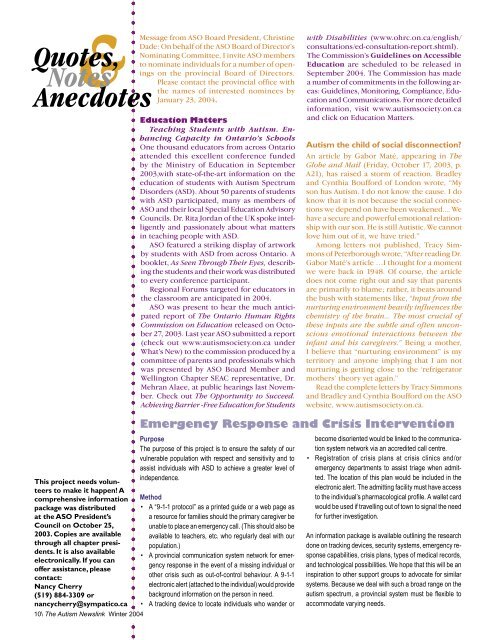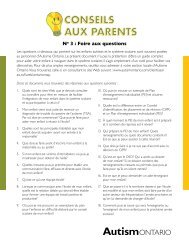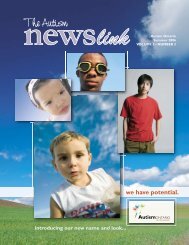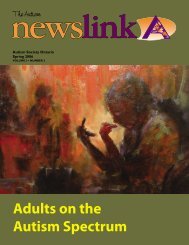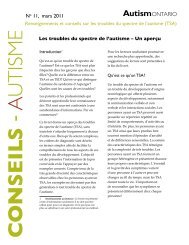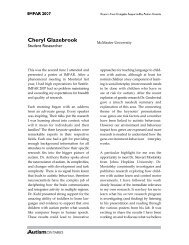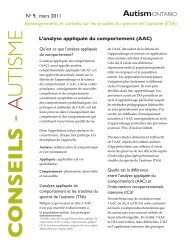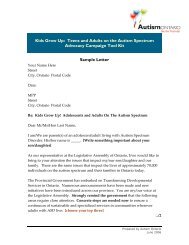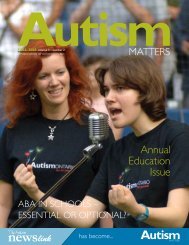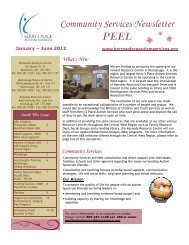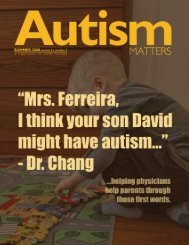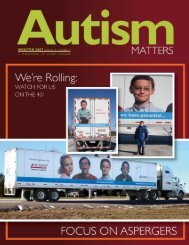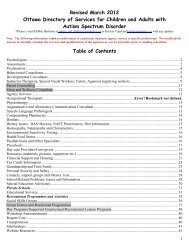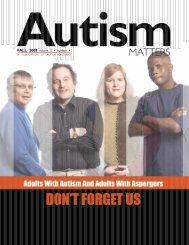Winter - Autism Ontario
Winter - Autism Ontario
Winter - Autism Ontario
You also want an ePaper? Increase the reach of your titles
YUMPU automatically turns print PDFs into web optimized ePapers that Google loves.
&<br />
Quotes,<br />
Notes<br />
An ec dotes<br />
This project needs volunteers<br />
to make it happen! A<br />
comprehensive information<br />
package was distributed<br />
at the ASO President’s<br />
Council on October 25,<br />
2003. Copies are available<br />
through all chapter presidents.<br />
It is also available<br />
electronically. If you can<br />
offer assistance, please<br />
contact:<br />
Nancy Cherry<br />
(519) 884-3309 or<br />
nancycherry@sympatico.ca<br />
Message from ASO Board President, Christine<br />
Dade: On behalf of the ASO Board of Director’s<br />
Nominating Committee, I invite ASO members<br />
to nominate individuals for a number of openings<br />
on the provincial Board of Directors.<br />
Please contact the provincial office with<br />
the names of interested nominees by<br />
January 23, 2004.<br />
Education Matters<br />
Teaching Students with <strong>Autism</strong>. Enhancing<br />
Capacity in <strong>Ontario</strong>’s Schools<br />
One thousand educators from across <strong>Ontario</strong><br />
attended this excellent conference funded<br />
by the Ministry of Education in September<br />
2003,with state-of-the-art information on the<br />
education of students with <strong>Autism</strong> Spectrum<br />
Disorders (ASD). About 50 parents of students<br />
with ASD participated, many as members of<br />
ASO and their local Special Education Advisory<br />
Councils. Dr. Rita Jordan of the UK spoke intelligently<br />
and passionately about what matters<br />
in teaching people with ASD.<br />
ASO featured a striking display of artwork<br />
by students with ASD from across <strong>Ontario</strong>. A<br />
booklet, As Seen Through Their Eyes, describing<br />
the students and their work was distributed<br />
to every conference participant.<br />
Regional Forums targeted for educators in<br />
the classroom are anticipated in 2004.<br />
ASO was present to hear the much anticipated<br />
report of The <strong>Ontario</strong> Human Rights<br />
Commission on Education released on October<br />
27, 2003. Last year ASO submitted a report<br />
(check out www.autismsociety.on.ca under<br />
What’s New) to the commission produced by a<br />
committee of parents and professionals which<br />
was presented by ASO Board Member and<br />
Wellington Chapter SEAC representative, Dr.<br />
Mehran Alaee, at public hearings last November.<br />
Check out The Opportunity to Succeed.<br />
Achieving Barrier -Free Education for Students<br />
Emergency Response and Crisis Intervention<br />
Purpose<br />
The purpose of this project is to ensure the safety of our<br />
vulnerable population with respect and sensitivity and to<br />
assist individuals with ASD to achieve a greater level of<br />
independence.<br />
Method<br />
• A “9-1-1 protocol” as a printed guide or a web page as<br />
a resource for families should the primary caregiver be<br />
unable to place an emergency call. (This should also be<br />
available to teachers, etc. who regularly deal with our<br />
population.)<br />
• A provincial communication system network for emergency<br />
response in the event of a missing individual or<br />
other crisis such as out-of-control behaviour. A 9-1-1<br />
electronic alert (attached to the individual) would provide<br />
background information on the person in need.<br />
• A tracking device to locate individuals who wander or<br />
with Disabilities (www.ohrc.on.ca/english/<br />
consultations/ed-consultation-report.shtml).<br />
The Commission’s Guidelines on Accessible<br />
Education are scheduled to be released in<br />
September 2004. The Commission has made<br />
a number of commitments in the following areas:<br />
Guidelines, Monitoring, Compliance, Education<br />
and Communications. For more detailed<br />
information, visit www.autismsociety.on.ca<br />
and click on Education Matters.<br />
<strong>Autism</strong> the child of social disconnection?<br />
An article by Gabor Maté, appearing in The<br />
Globe and Mail (Friday, October 17, 2003, p.<br />
A21), has raised a storm of reaction. Bradley<br />
and Cynthia Boufford of London wrote, “My<br />
son has <strong>Autism</strong>. I do not know the cause. I do<br />
know that it is not because the social connections<br />
we depend on have been weakened.... We<br />
have a secure and powerful emotional relationship<br />
with our son. He is still Autistic. We cannot<br />
love him out of it, we have tried.”<br />
Among letters not published, Tracy Simmons<br />
of Peterborough wrote, “After reading Dr.<br />
Gabor Maté’s article …I thought for a moment<br />
we were back in 1948. Of course, the article<br />
does not come right out and say that parents<br />
are primarily to blame; rather, it beats around<br />
the bush with statements like, “Input from the<br />
nurturing environment heavily influences the<br />
chemistry of the brain... The most crucial of<br />
these inputs are the subtle and often unconscious<br />
emotional interactions between the<br />
infant and his caregivers.” Being a mother,<br />
I believe that “nurturing environment” is my<br />
territory and anyone implying that I am not<br />
nurturing is getting close to the ‘refrigerator<br />
mothers’ theory yet again.”<br />
Read the complete letters by Tracy Simmons<br />
and Bradley and Cynthia Boufford on the ASO<br />
website, www.autismsociety.on.ca.<br />
become disoriented would be linked to the communication<br />
system network via an accredited call centre.<br />
• Registration of crisis plans at crisis clinics and/or<br />
emergency departments to assist triage when admitted.<br />
The location of this plan would be included in the<br />
electronic alert. The admitting facility must have access<br />
to the individual’s pharmacological profile. A wallet card<br />
would be used if travelling out of town to signal the need<br />
for further investigation.<br />
An information package is available outlining the research<br />
done on tracking devices, security systems, emergency response<br />
capabilities, crisis plans, types of medical records,<br />
and technological possibilities. We hope that this will be an<br />
inspiration to other support groups to advocate for similar<br />
systems. Because we deal with such a broad range on the<br />
autism spectrum, a provincial system must be flexible to<br />
accommodate varying needs.<br />
CAIRN Review helps parents<br />
“navigate the research maze”<br />
Finding it hard to sift the wheat from the chaff<br />
when it comes to information on autism?<br />
Help is on the horizon in the form of a new<br />
publication produced by The Canadian <strong>Autism</strong><br />
Intervention Research Network.<br />
The CAIRN Review of Evidence-based Diagnosis<br />
and Treatment in <strong>Autism</strong> is designed to<br />
help both parents and professionals make sense<br />
of all the conflicting research on autism so they<br />
can make better choices around treatment and<br />
services.<br />
“An important part of our role is helping parents,<br />
clinicians and others in the autism community<br />
navigate the research maze,” says Sherry<br />
Cecil, who directs public outreach activities for<br />
CAIRN, a network of parents, researchers and<br />
professionals dedicated to promoting evidencebased<br />
practice in autism.<br />
“There is so much information out there that<br />
it’s overwhelming. We search the research and<br />
let people know what the evidence is so they can<br />
make informed choices,” says Cecil.<br />
The first CAIRN Review is hot off the press and<br />
includes articles on how to spot early markers for<br />
autism, new developments in drug therapy, and<br />
the increased risk of depression and anxiety in<br />
adolescents with ASD.<br />
Five Awards Given for<br />
New Sibling Scholarship<br />
At ASO’s annual general meeting, the<br />
newly formed Jeanette Holden Post<br />
Secondary Scholarship for Siblings of<br />
Students with ASD was awarded to five siblings<br />
of a brother or sister with an <strong>Autism</strong><br />
Spectrum Disorder (ASD). These young<br />
people all applied with acceptance letters<br />
to various universities in <strong>Ontario</strong> in order<br />
to continue their academic pursuits. Each<br />
successful applicant was awarded $1,000.<br />
This year’s recipients were:<br />
Jennifer Kloosterman, Hastings<br />
Alicia McPhail, Pickering<br />
Joanna Northover, Ottawa<br />
Holly Pearce, Burlington<br />
Kent Randall, Peterborough<br />
Congratulations!<br />
The following is reprinted from the CAIRN Review<br />
of Evidence-based Diagnosis and Treatment in<br />
<strong>Autism</strong>, November 2003.<br />
RISK MARKERS (‘RED FLAGS’) FOR AUTISM<br />
Failure to achieve any of the following milestones:<br />
• Babbling by 11 months<br />
• Simple gestures (e.g. waving) by 12 months<br />
• Single words by 16 months<br />
• 2-word phrases (a noun and a verb) by 24 months<br />
Loss of any language or social skills at any age<br />
Doesn’t respond when name is called<br />
Rarely makes eye contact when interacting with other<br />
people<br />
Doesn’t point to show things he/she is interested in<br />
Doesn’t smile socially<br />
More interested in looking at objects than at people’s<br />
faces<br />
Seems to prefer to play alone<br />
Doesn’t make attempts to get parents’ attention<br />
Seems to be ‘in own world’<br />
Doesn’t respond to or avoids parents’ attempts to play,<br />
even if relaxed<br />
Avoids or ignores other children when they approach<br />
him/her<br />
Has odd or repetitive ways of moving his/her hands<br />
and/or fingers<br />
Seems oversensitive to certain textures or sounds<br />
Lacks interest in toys, or plays with them in an unusual way<br />
(e.g. ‘lining up’, spinning, opening/closing parts rather<br />
than using the toy as a whole)<br />
Has compulsions/rituals (has to perform activities in a<br />
special way or sequence)<br />
p Scholarship recipient Alicia McPhail with Dr. Jeanette<br />
Holden<br />
Kent Randall who was one of the recipients through this<br />
scholarship wrote, “It is an honour to receive this award.<br />
My youngest brother who lives with autism, has taught<br />
me patience, understanding and tolerance. He has<br />
inspired me to set high standards and goals for myself,<br />
and I am sure that inspiration will follow me.” u<br />
The articles can be viewed<br />
on the CAIRN website,<br />
www.cairn-site.com.<br />
Free subscriptions to the<br />
newsletter, which will be<br />
published three times a<br />
year, can also be ordered<br />
directly from the site or by<br />
contacting the Editor at<br />
info@cairn-site.com.<br />
10\ The <strong>Autism</strong> Newslink <strong>Winter</strong> 2004 The <strong>Autism</strong> Newslink <strong>Winter</strong> 2004 /11


